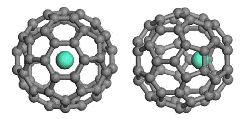Chemistry, Department of: Faculty Series

Xiao Cheng Zeng Publications
Document Type
Article
Date of this Version
2019
Citation
Published in The Journal of Physical Chemistry Letters 10 (2019), pp 1820-1827.
DOI: 10.1021/acs.jpclett.9b00446
Abstract
Among coinage metal nanoclusters with 55 atoms, only Ag55– and Cu55– are the geometric magic-number clusters, as both exhibit icosahedral symmetry. Au55–, however, exhibits much lower symmetry due largely to the strong relativistic bonding effect. In this study, we collect a much larger population (>10,000 isomers) of low-energy isomers of Au55– to Au60– by using the combined density-functional theory and basin-hopping global optimization method. We also include the spin−orbit effect in the density-functional theory computation to achieve simulated photoelectron spectra in quantitative fashion. Remarkably, we uncover that the Au13 core with the highest icosahedral (Ih) symmetry emerges at the size of Au60–. Stability analysis suggests that Au57– with 58 valence electrons, an electronic magic number, is the relatively more stable cluster in the size range considered. Overall, in this size range we reveal a compromise between the trend toward having a perfect icosahedral 13-atom core and the strong relativistic bonding effect.
Supplemental files


Comments
Copyright © 2019 American Chemical Society. Used by permission.